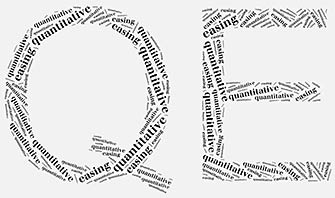The QE Head Fake: Why There's Still Plenty of Easing Going On

So after six years, Quantitative Easing has come and gone … or has it? While the jury is still out about the extent to which it has helped the economy, we are also left with lingering questions about the Fed’s accommodative precedent and whether Wall Street is now truly back to normal.
Since the beginning of QE, the markets have been artificially stimulated by wave after wave of economic easing. Each time the Dow started to slump, another bubble was launched keeping things inflated and over-stated. QE 1 was introduced back in November of 2008. QE 2 came in November of 2010. QE 3, which was open-ended, was unleashed on December 12, 2012 and saw Federal bond purchases soar to $85 billion per month … earning it the name QE Infinity.
“Infinity” is the operative word here. Wall Street has gotten so comfortably high and value-numb that life without the Fed now seems implausible and in many ways it is. Make no mistake about it … there’s still plenty of easing going on.
The Fed is sitting on a multi-trillion dollar portfolio chock full of bonds and securities that they are in no hurry to sell. Keeping them off the market impacts prices and as they mature the Fed is actively re-investing billions a month to maintain the size and scale of its central bank holdings. This enables them to keep borrowing costs low, keep interest rates at near-zero, and help maintain “accommodative financial conditions.” They just can’t help themselves. Cheap cash makes the markets feel good and gives the illusion of real earnings, and that’s all that matters during a crisis. But our inability to get out of crisis mode is troubling.
In the wake of one of the largest economic interventions in modern history, the US balance sheet now stands at $4.48 trillion dollars … having more than quadrupled. The Fed has compiled an unenviable collection of long-term debt and mortgage bonds of every size and shape leaving many experts wondering how it can possibly extricate itself from such a massive monetary commitment without sending the economy into a tailspin. Ironically, the Fed does not seem concerned and clearly has no sense of urgency. It is an inherently irrational posture and one that seems to deny cause and effect.
While this historic manipulation of the money supply has sent stocks to fanciful levels, it has also divorced Wall Street from economic reality. The market is no longer an accurate barometer of our fiscal health and the unceremonious end of QE does not mean that the economy is now on solid footing. The policy focus of the Federal Reserve has clearly hinged on this notion of “considerable time” particularly with respect to keeping interest rates low, which begs the question … what happens when “time” runs out and interest rates finally do rise?
The reality is that the credible economic benchmarks for “the recovery” have not yet come. The task of cleaning and reconciling the Fed’s bloated balance sheets has not yet begun. The fiscal stress tests that measure whether the economy can function under its own power have not been performed. One thing is for certain, however … easy money, mass stimulus measures, and protracted QE will now forever be part of the Fed’s economic “fix-it” kit. And, Yellen has made it clear that the Fed will not hesitate to do it all again.